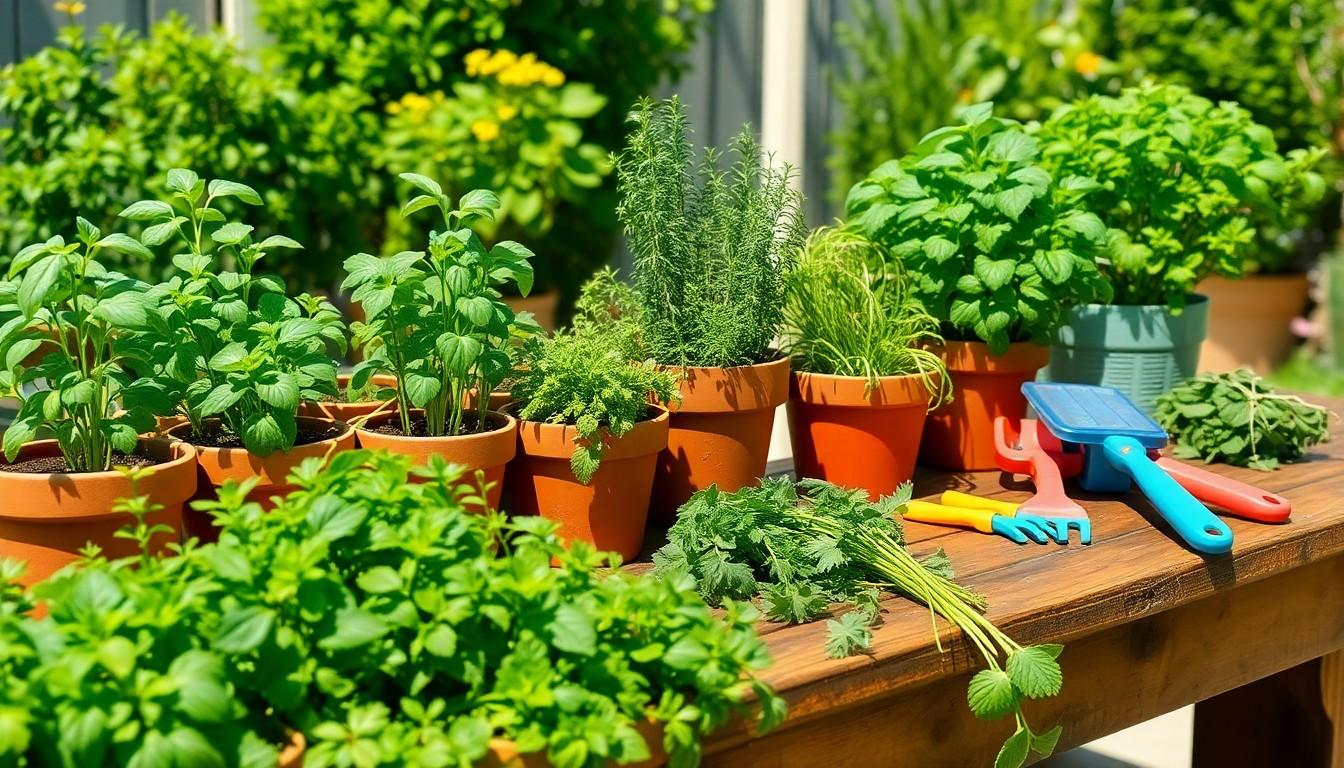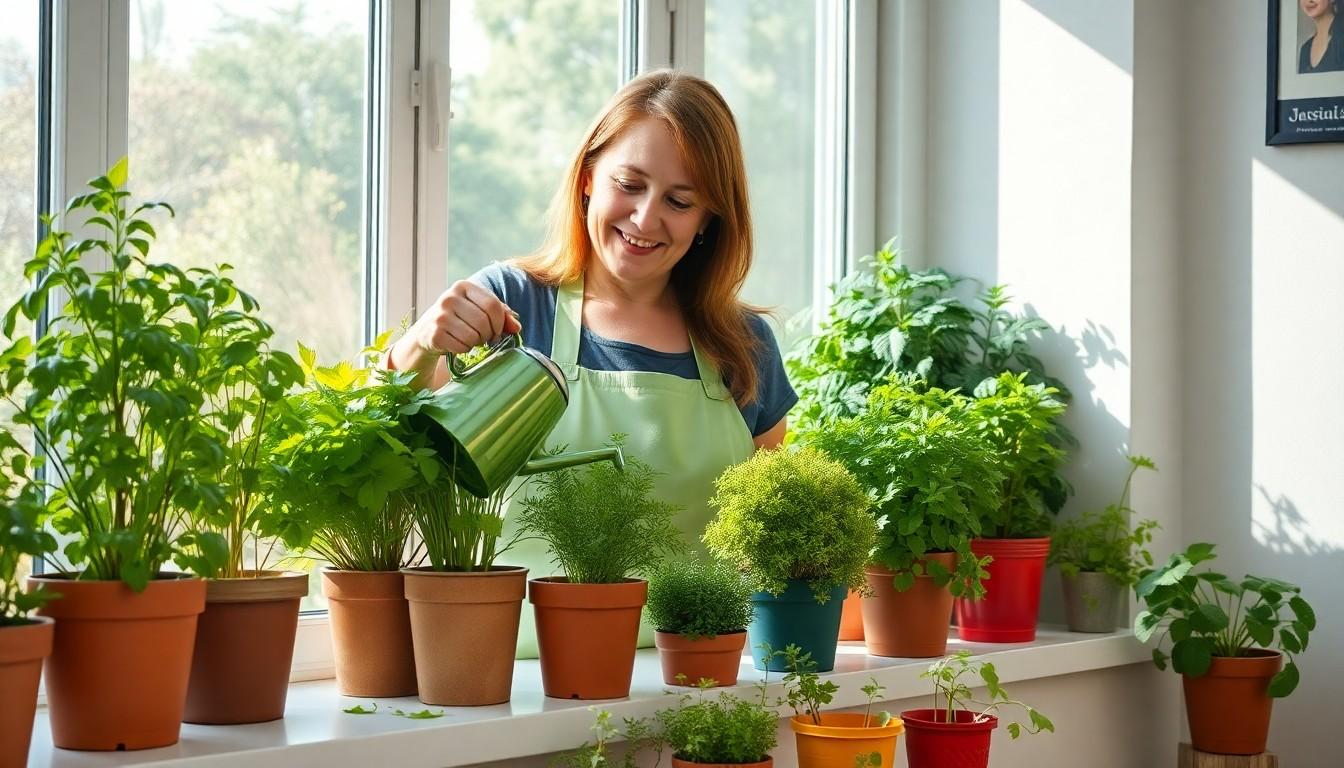Imagine stepping into your kitchen and plucking fresh basil or rosemary right from your windowsill. Growing herbs isn’t just for seasoned gardeners; it’s for anyone who wants to add a splash of flavor to their meals and a hint of greenery to their space. Whether you’ve got a sprawling backyard or just a tiny apartment, there’s a herb-growing idea that’ll fit right in.
Herbs are like the rock stars of the culinary world—easy to grow, low-maintenance, and they’ll make your dishes taste like a five-star restaurant. From vertical gardens to quirky pots, the possibilities are endless. So roll up those sleeves and get ready to unleash your inner green thumb. With a little creativity and a dash of humor, growing herbs can be a delightful adventure that spices up both your cooking and your home.
Herb Growing Ideas
Herb gardening offers various creative options for enthusiasts. Explore these popular methods to grow herbs both indoors and outdoors.
Indoor Herb Gardens
Growing herbs indoors provides fresh flavors year-round. Choose windowsills with abundant sunlight for optimal growth. Pots made from clay or ceramic retain moisture better than plastic ones. Basil, cilantro, and parsley thrive in smaller containers. Use lightweight potting mix that promotes drainage. Regularly check moisture levels, as indoor environments can dry out plants quickly. Consider grow lights if natural light is limited, ensuring consistent growth.
Outdoor Herb Gardens
Creating outdoor herb gardens enhances culinary experiences and beautifies landscapes. Select a sunny spot with well-draining soil for planting. Consider raised beds for improved accessibility and pest control. Popular herbs like rosemary, thyme, and mint prefer ample sunlight and rich soil. Group herbs based on companion planting to promote growth and deter pests. Water plants consistently, allowing soil to dry slightly between watering. Utilizing mulch helps retain moisture and regulates soil temperature.
Best Herbs for Beginners

Growing herbs can be simple and rewarding for beginners. Certain herbs require minimal care and thrive in various environments.
Easy-to-Grow Herbs
Basil ranks among the top choices for novice gardeners. It flourishes in warm conditions and just needs regular watering. Chives also make an excellent option, providing a mild onion flavor that enhances various dishes. They adapt well to pots or garden beds. Another easy herb is mint, known for its vigorous growth. It can quickly spread, making it perfect for containers that limit its reach. Lastly, parsley adds green accents to gardens while being straightforward to maintain. These herbs enrich meals and offer a manageable introduction to gardening.
Culinary Herbs
Culinary herbs can transform everyday dishes into gourmet experiences. Oregano serves as a staple in Italian cuisine, thriving in full sun and well-drained soil. Rosemary brings a robust flavor, ideal for roasted meats and vegetables. This herb prefers dryer conditions and can be grown in pots. Cilantro remains popular in various cuisines, particularly Mexican and Asian dishes. It grows quickly and offers fresh leaves for seasoning. Lastly, thyme, with its earthy aroma, complements many recipes and requires minimal attention. Starting with these culinary herbs showcases the versatility and excitement of home gardening.
Innovative Herb Growing Techniques
Exploring innovative techniques enhances the herb growing experience, making it more effective and enjoyable. Two popular methods stand out: hydroponics and vertical gardening.
Hydroponics
Hydroponics involves growing herbs without soil, using nutrient-rich water instead. This technique allows for faster growth and higher yields, as plants directly access nutrients. Many herbs, including basil and mint, thrive in hydroponic systems. A key advantage is the ability to control pH levels and nutrient concentrations easily. Additionally, indoor setups reduce pest problems and maximize space utilization. Using hydroponic kits simplifies the process, making it accessible for beginners. Modular systems allow for scalability, accommodating any available space.
Vertical Gardening
Vertical gardening emphasizes efficient space use by growing herbs upward instead of outward. This method suits urban environments where garden space is limited. Various structures, such as wall-mounted planters or tiered shelves, support herb growth while adding visual appeal. Ideal choices for vertical gardens include trailing herbs like oregano and thyme. These plants adapt well to vertical layouts and provide lush greenery. Regular watering and adequate sunlight remain essential for success. By creating a vertical herb garden, one can enhance aesthetics while enjoying fresh herbs right at home.
Tips for Successful Herb Gardening
Achieving success in herb gardening involves understanding specific needs. Proper soil and water are fundamental for healthy growth.
Soil and Water Requirements
Soil choice impacts herb vitality significantly. Use well-draining potting mixes or garden soil designed for herbs. Increasing drainage can prevent root rot, which often occurs in overly saturated environments. Water thoroughly but avoid waterlogged conditions; herbs prefer consistent moisture without stagnation. Opt for watering when the top inch of soil feels dry to the touch. Consider using self-watering pots to help maintain proper moisture levels, particularly for indoor plants. Assess herbs’ specific needs, as some like basil thrive in slightly more moisture, while rosemary prefers drier conditions.
Pest Management
Effective pest management ensures herbs remain healthy and productive. Regularly inspect plants for common pests like aphids, spider mites, and whiteflies. Implement natural deterrents; neem oil or insecticidal soap can reduce pest populations without harming beneficial insects. Maintaining proper spacing between plants improves airflow and minimizes diseases. Introducing companion plants that attract predatory insects offers an ecological solution to pest problems. Thinning out overcrowded plants also aids in reducing hiding spots for pests. An organic approach is generally safer for culinary uses, ensuring that herbs remain healthy and flavorful. Growing herbs at home opens up a world of flavor and creativity. Whether one opts for indoor pots or outdoor gardens the process is both enjoyable and fulfilling. With various methods available from hydroponics to vertical gardening anyone can find a way to cultivate herbs that fit their lifestyle and space.
Choosing the right herbs like basil or mint can make a significant difference in culinary experiences. By following simple care tips and understanding each herb’s needs gardeners can ensure their plants thrive. Embracing herb gardening not only enhances meals but also adds a vibrant touch to any living space. The journey of growing herbs is just as rewarding as the final harvest.

